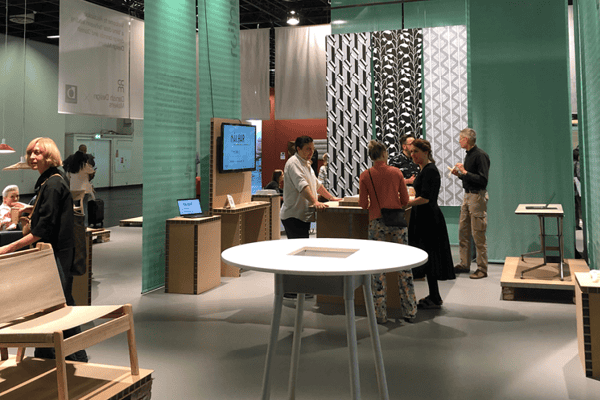
What is downcycling?
Downcycling happens when recycled materials lose quality compared to their original state. This means they can’t be used for all its previous applications. Even though downcycled materials still count as recycled, they are often less valuable and less useful.
For example, high-quality steel might get mixed with lower-quality metal during recycling. The final product is of less quality and can no longer be used for demanding applications like structural car parts—it might only be good for something less demanding, like construction beams.
Downcycling is not done on purpose—it’s an unwanted side effect of the recycling process. It happens when materials get mixed, contaminated, or are too expensive to clean and restore. Or when high quality recycled materials are used for a less valuable purpose than it could be used for.
For example, when recycled PET from drinking bottles are used to make polyester yarn for clothing. Even though a t-shirt made from recycled polyester might be more expensive than a plastic bottle, the quality requirements for yarns are less demanding than those for plastics used for foods. This means that the portion of recycled PET from previous bottles that can be used for new plastic bottles gets smaller when it instead is used for clothing.
High-grade metal or high-grade metal alloys are for example stainless steel or heat resistant steel. They are mixed with a larger amount of alloying components that increase specific qualities. So, a metal alloy is the mix of metal and additives that make the many different types of speciality or ordinary metals that we use for various purposes.
Why does downcycling happen?
- Mixing different materials: When different types of materials are collected and not separated properly, the overall quality drops. For example, high grade metal alloys with valuable ingredients might get mixed with regular metal alloys, making it impossible to recover the original high-quality material.
- Contamination: If unwanted substances (like dirt or harmful chemicals) get into the recycling process, they can reduce quality. For example, if copper from wires ends up in steel recycling, it can weaken the steel. Or when plastic parts from electronic items, containing toxic fire retarding chemicals, enter into the waste stream. Cleaning out these contaminants may be impossible or require much extra effort, making recycling less efficient and hereby more energy demanding.
- Low market demand: Sometimes, a material is recyclable, but nobody needs it. For example, old glass from bulky TV screens used to be easy to recycle when those TVs were popular. But now that we use flat screens, there’s little demand for that type of glass, making it hard to reuse it in the same way.
- Difficult-to-recycle product design – Modern products are made from many different materials combined in ways that can be difficult to separate. If materials can’t be easily taken apart, they often end up in lower-quality applications instead of being fully recycled.
How can we identify and measure downcycling?
Downcycling can be divided into three main groups of specific problems. A recycled material can belong to one or more of these:
- Thermodynamic downcycling: This is happens when recycling requires more energy, heat, or additional materials to restore quality than what is economically feasible.
- Functional downcycling: This means the recycled material can’t be used for the same applications as before. An example is when high-quality plastic is contaminated with other types of plastic and/or additives so that it can only be used in less demanding applications. Then it has been functionally downcycled.
- Economic downcycling: This happens when recycled material loses value and sells for a lower price than before. If companies are willing to pay less for a recycled material because it’s lower quality, economic downcycling has occurred.

Why should you be aware of downcycling?
Downcycling makes recycling less effective because we lose some of the material’s original value. To reduce downcycling and improve recycling, we need to:
- Keep materials as clean and pure as possible
- Avoid mixing high-quality materials with lower-quality ones, and
- Design products that are easier to recycle properly.
Understanding downcycling helps us make better choices about how we recycle and how we design materials for the future.
Source: A terminology for downcycling by Helbig et al 2022.
When recycling becomes downcycling
So, what can you do to avoid downcycling when you want to integrate recycled materials into your products?
And remember, here we are talking about materials that have been used, have been broken down or remelted, and made into a new material. We are not talking about using left over materials.
A popular trend is to take recycled plastic made from used drinking bottles and turn it into polyester yarn that can be used for clothing, curtains, carpets, or stuffed toy animals. If this yarn is mixed in production with e.g. wool or cotton, it is difficult to separate it at (second) end of life, and thus it stops being recyclable and leaves the recycling loop.
Furthermore, recycled plastic from used drinking bottles is a clean and pure food grade material, that can be used for making new food packaging – items that is under strict hygiene requirements. Thus, taking this material out of its loop is downcycling. If you instead use other types of post-consumer plastic waste or so-called ocean plastic like destroyed fishing nets to blend into your textile production, you give new life to waste that would otherwise have been incinerated, landfilled or left in nature. And which would require much sorting, cleaning and processing to retake its former purpose/shape.
Recycling of solid wood and wood based boards
Recycling solid wood is automatically downcycling, because you can never restore its original shape and qualities. Solid wood is primarily downcycled into wood fibres that can be used for wood-based boards. However, solid wood is typically very durable and can be maintained for many years. It can be repolished and retreated to keep its beauty and durability for decades. It can also be incinerated for energy production which is of course also a downcycling.
Wood based boards can be chopped down to fibres and remade into new boards like MDF and HDF where it is difficult to obtain the same fine fibre quality. However, degrading fibre length in each recycling and contaminants limits the number of times recycling is possible. As society have a high need for energy, it can in many cases be more beneficial to incinerate the old wooden boards in comparison to fossil fuel alternatives.
Recyling of metal and glass
Most metals are easy to recycle because there are established and well-functioning recycling systems for metals. However, the remelting and forming of metal requires high temperatures and thus high amounts of energy. This, on the other hand, entails that whatever you might coat it with, will evaporate in the melting process. But if high-quality metals are “contaminated” with lower-quality metals it can limit the application possibilities for the recycled metal.
Like metals, glass is easy to recycle if it is not polluted with other types of glass than the one used for container packaging. But the process requires high temperatures and thus large amounts of energy, so the climate benefit is limited.
Downgrading of glass recycling happens when glass cannot be properly sorted into fractions of different colours reducing its value as packaging glass.
If the glass waste is polluted with other types of glass (window glass, domestic glass, etc), it cannot be remelted and made into containers and is instead downgraded to crushed aggregates or thermal insulation bats or blocks.
Recycling of upholstery and covers
Textiles are in general difficult to recycle, because they often are made of various types of fibres. The subsequent spinning, weaving and dyeing processes require a lot of energy and hereby also reduces the climate benefit of recycling. The recycling of textiles might also require adding of virgin material because the shredded fibres are too short to provide the needed yarn strength.
Examples of downcycling of recycled textile is when the fibres are of different type or too short so that they can only be used for less demanding applications like felt or fibre bats.
PU foam can be recycled through gluing used foam particles together in compression. This increases the density compared to the former foam material resulting in a heavier material with lower elastic properties. Subsequently PU foam from recycled foam particles is a downgraded material of lower quality than the virgin foam.
Summing up
Overall, we have three suggestions for you:
- Support closed loop recycling
- Ensure that your products made from recycled materials continue to be recyclable
- Reduce your use of materials, be it recycled or virgin
As you can see, there are a lot of relevant considerations to take into account when you want to integrate recycled materials into your products. But they are important to secure optimal use of our limited resources and thereby taking better care of the next generations’ opportunities to fulfil their needs.


